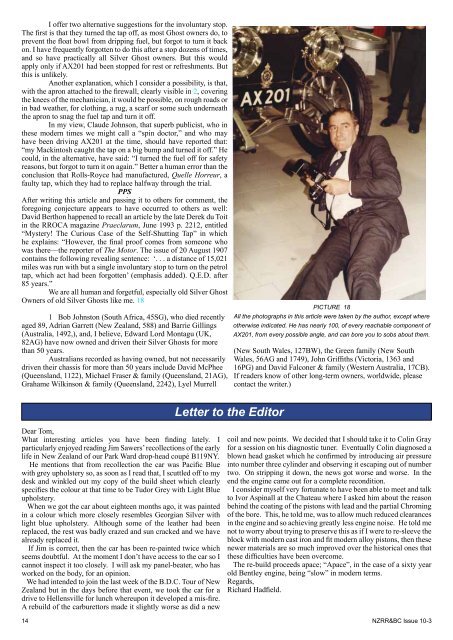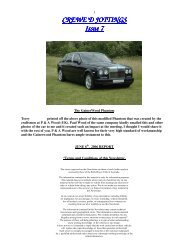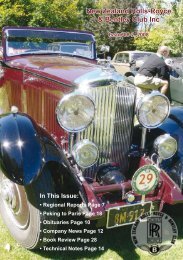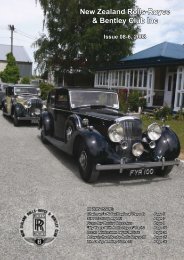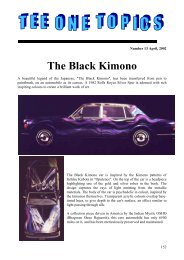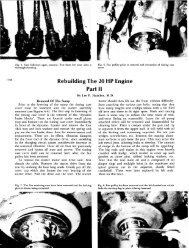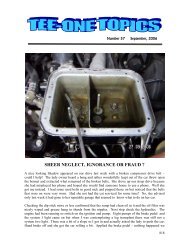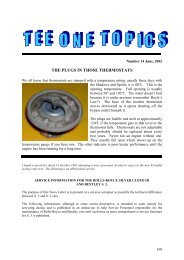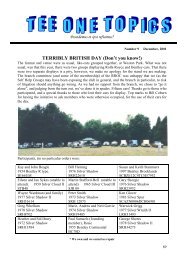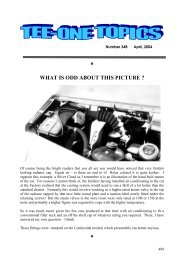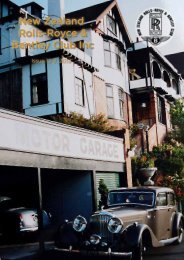New Zealand Rolls-Royce & Bentley Club Inc - The Enthusiasts ...
New Zealand Rolls-Royce & Bentley Club Inc - The Enthusiasts ...
New Zealand Rolls-Royce & Bentley Club Inc - The Enthusiasts ...
Create successful ePaper yourself
Turn your PDF publications into a flip-book with our unique Google optimized e-Paper software.
I offer two alternative suggestions for the involuntary stop.<br />
<strong>The</strong> first is that they turned the tap off, as most Ghost owners do, to<br />
prevent the float bowl from dripping fuel, but forgot to turn it back<br />
on. I have frequently forgotten to do this after a stop dozens of times,<br />
and so have practically all Silver Ghost owners. But this would<br />
apply only if AX201 had been stopped for rest or refreshments. But<br />
this is unlikely.<br />
Another explanation, which I consider a possibility, is that,<br />
with the apron attached to the firewall, clearly visible in 2, covering<br />
the knees of the mechanician, it would be possible, on rough roads or<br />
in bad weather, for clothing, a rug, a scarf or some such underneath<br />
the apron to snag the fuel tap and turn it off.<br />
In my view, Claude Johnson, that superb publicist, who in<br />
these modern times we might call a “spin doctor,” and who may<br />
have been driving AX201 at the time, should have reported that:<br />
“my Mackintosh caught the tap on a big bump and turned it off.” He<br />
could, in the alternative, have said: “I turned the fuel off for safety<br />
reasons, but forgot to turn it on again.” Better a human error than the<br />
conclusion that <strong>Rolls</strong>-<strong>Royce</strong> had manufactured, Quelle Horreur, a<br />
faulty tap, which they had to replace halfway through the trial.<br />
PPS<br />
After writing this article and passing it to others for comment, the<br />
foregoing conjecture appears to have occurred to others as well:<br />
David Berthon happened to recall an article by the late Derek du Toit<br />
in the RROCA magazine Praeclarum, June 1993 p. 2212, entitled<br />
“Mystery! <strong>The</strong> Curious Case of the Self-Shutting Tap” in which<br />
he explains: “However, the final proof comes from someone who<br />
was there—the reporter of <strong>The</strong> Motor. <strong>The</strong> issue of 20 August 1907<br />
contains the following revealing sentence: ‘. . . a distance of 15,021<br />
miles was run with but a single involuntary stop to turn on the petrol<br />
tap, which act had been forgotten’ (emphasis added). Q.E.D. after<br />
85 years.”<br />
We are all human and forgetful, especially old Silver Ghost<br />
Owners of old Silver Ghosts like me. 18<br />
1 Bob Johnston (South Africa, 45SG), who died recently<br />
aged 89, Adrian Garrett (<strong>New</strong> <strong>Zealand</strong>, 588) and Barrie Gillings<br />
(Australia, 1492,), and, I believe, Edward Lord Montagu (UK,<br />
82AG) have now owned and driven their Silver Ghosts for more<br />
than 50 years.<br />
Australians recorded as having owned, but not necessarily<br />
driven their chassis for more than 50 years include David McPhee<br />
(Queensland, 1122), Michael Fraser & family (Queensland, 21AG),<br />
Grahame Wilkinson & family (Queensland, 2242), Lyel Murrell<br />
PICTURE 18<br />
All the photographs in this article were taken by the author, except where<br />
otherwise indicated. He has nearly 100, of every reachable component of<br />
AX201, from every possible angle, and can bore you to sobs about them.<br />
(<strong>New</strong> South Wales, 127BW), the Green family (<strong>New</strong> South<br />
Wales, 56AG and 1749), John Griffiths (Victoria, 1363 and<br />
16PG) and David Falconer & family (Western Australia, 17CB).<br />
If readers know of other long-term owners, worldwide, please<br />
contact the writer.)<br />
Letter to the Editor<br />
Dear Tom,<br />
What interesting articles you have been finding lately. I<br />
particularly enjoyed reading Jim Sawers’ recollections of the early<br />
life in <strong>New</strong> <strong>Zealand</strong> of our Park Ward drop-head coupé B119NY.<br />
He mentions that from recollection the car was Pacific Blue<br />
with grey upholstery so, as soon as I read that, I scuttled off to my<br />
desk and winkled out my copy of the build sheet which clearly<br />
specifies the colour at that time to be Tudor Grey with Light Blue<br />
upholstery.<br />
When we got the car about eighteen months ago, it was painted<br />
in a colour which more closely resembles Georgian Silver with<br />
light blue upholstery. Although some of the leather had been<br />
replaced, the rest was badly crazed and sun cracked and we have<br />
already replaced it.<br />
If Jim is correct, then the car has been re-painted twice which<br />
seems doubtful. At the moment I don’t have access to the car so I<br />
cannot inspect it too closely. I will ask my panel-beater, who has<br />
worked on the body, for an opinion.<br />
We had intended to join the last week of the B.D.C. Tour of <strong>New</strong><br />
<strong>Zealand</strong> but in the days before that event, we took the car for a<br />
drive to Hellensville for lunch whereupon it developed a mis-fire.<br />
A rebuild of the carburettors made it slightly worse as did a new<br />
coil and new points. We decided that I should take it to Colin Gray<br />
for a session on his diagnostic tuner. Eventually Colin diagnosed a<br />
blown head gasket which he confirmed by introducing air pressure<br />
into number three cylinder and observing it escaping out of number<br />
two. On stripping it down, the news got worse and worse. In the<br />
end the engine came out for a complete recondition.<br />
I consider myself very fortunate to have been able to meet and talk<br />
to Ivor Aspinall at the Chateau where I asked him about the reason<br />
behind the coating of the pistons with lead and the partial Chroming<br />
of the bore. This, he told me, was to allow much reduced clearances<br />
in the engine and so achieving greatly less engine noise. He told me<br />
not to worry about trying to preserve this as if I were to re-sleeve the<br />
block with modern cast iron and fit modern alloy pistons, then these<br />
newer materials are so much improved over the historical ones that<br />
these difficulties have been overcome.<br />
<strong>The</strong> re-build proceeds apace; “Apace”, in the case of a sixty year<br />
old <strong>Bentley</strong> engine, being “slow” in modern terms.<br />
Regards,<br />
Richard Hadfield.<br />
14 NZRR&BC Issue 10-3


